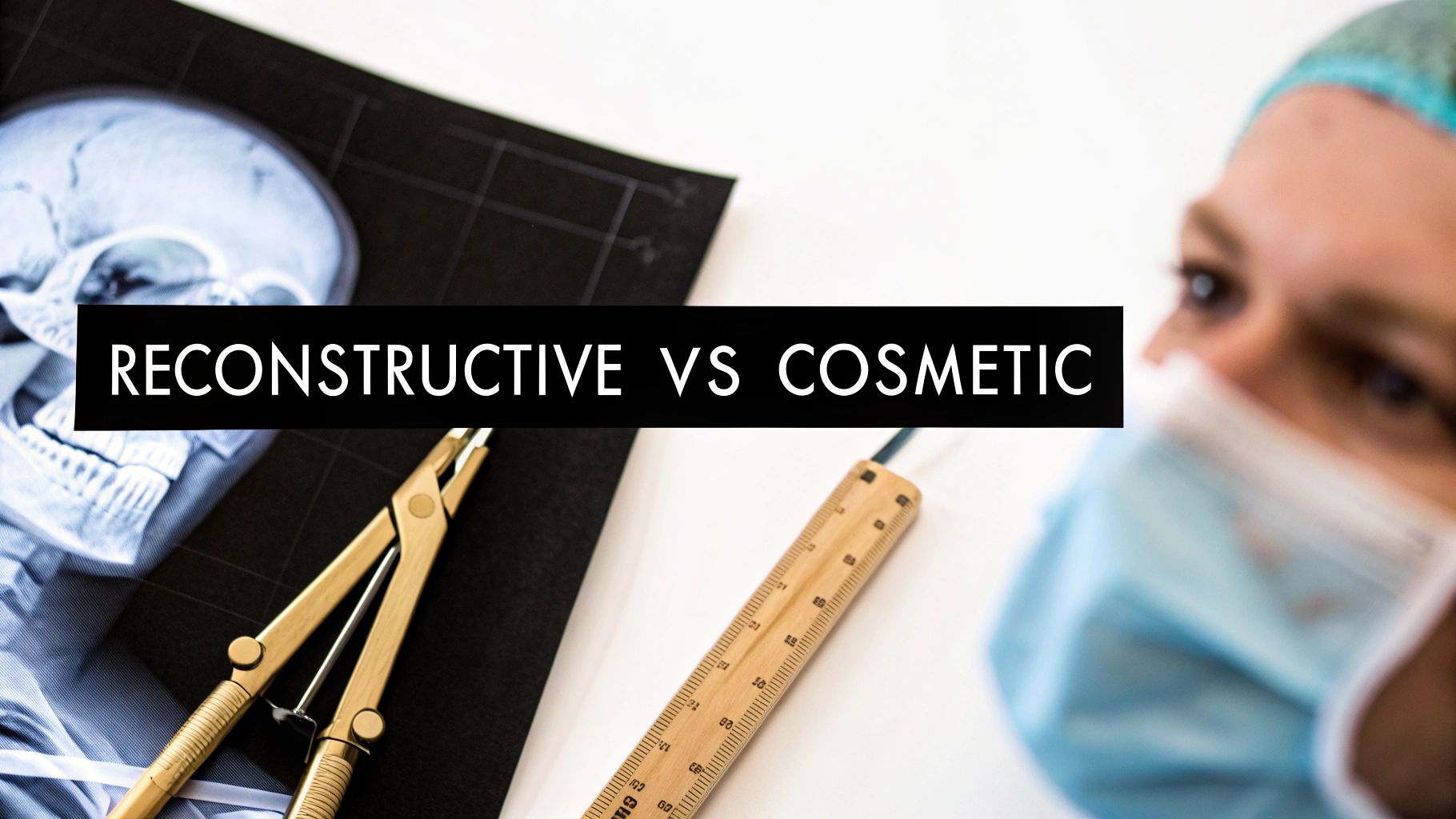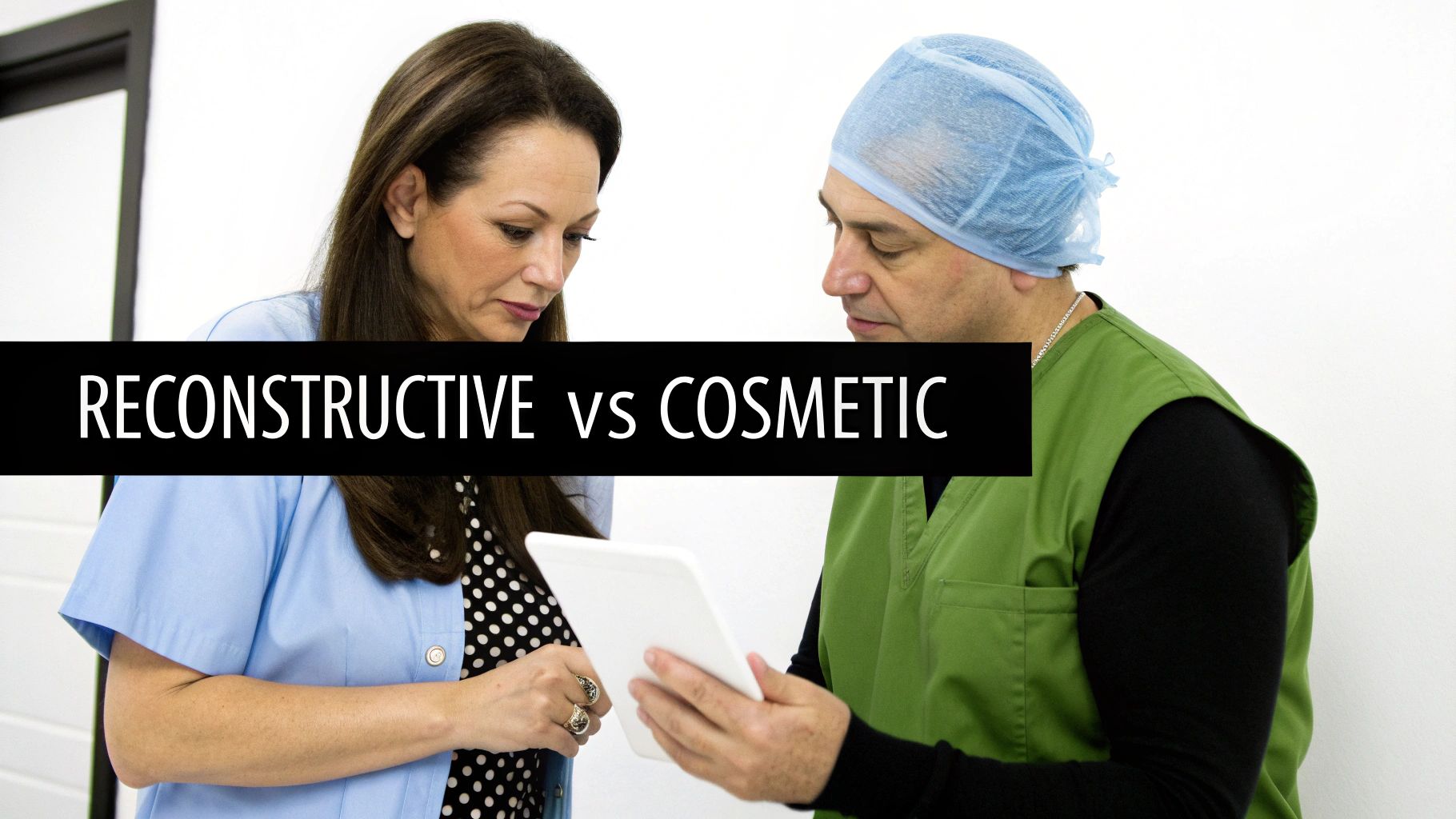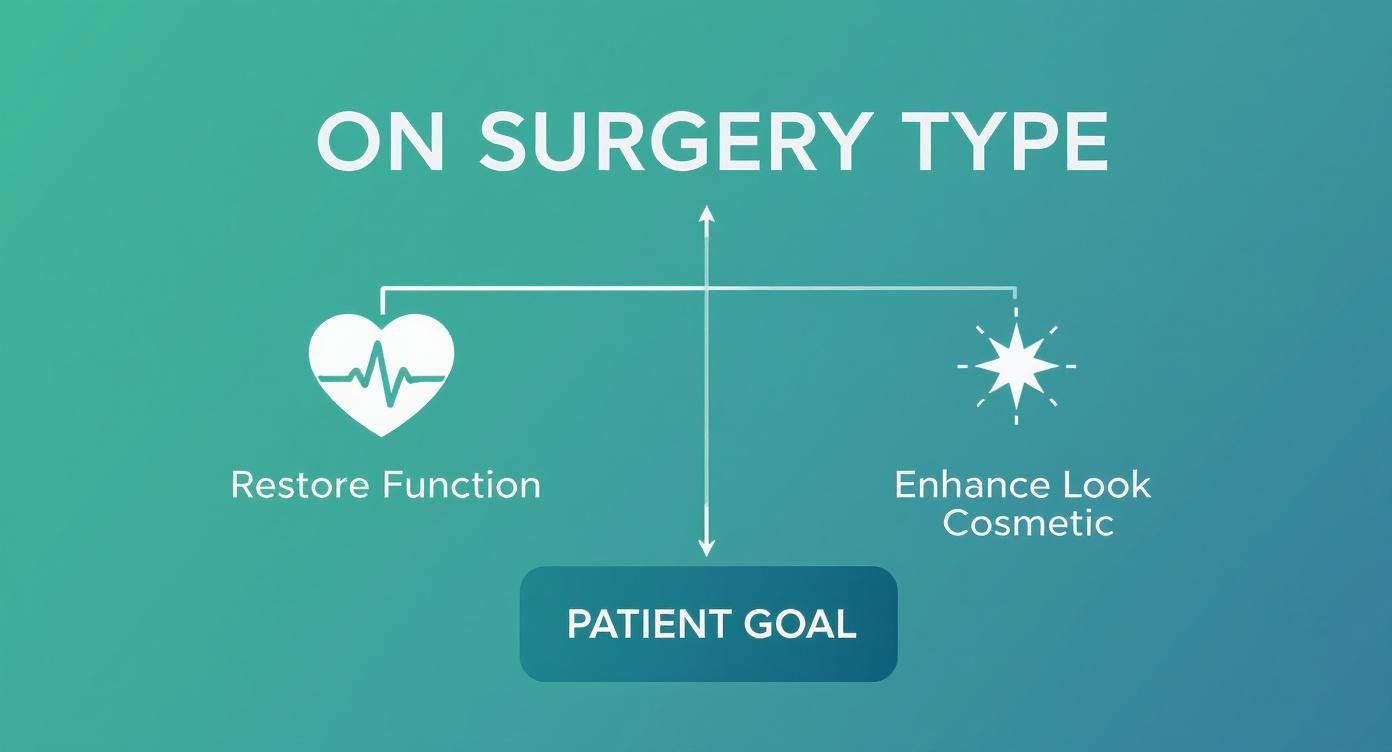
December 25, 2025
How to Make My Neck Thinner: A Practical Guide
Learn how to make my neck thinner with practical exercises, non-surgical options, and tips for a defined jawline.
Nov 10, 2025

When people hear "plastic surgery," they often picture procedures aimed at changing one's appearance. But that's only half the story. The field is broadly split into two distinct areas: reconstructive surgery and cosmetic surgery. The biggest difference between them really boils down to necessity versus choice.
Reconstructive surgery is performed to correct a physical problem or abnormality, often one that impacts a person's health or ability to function. Cosmetic surgery, on the other hand, is an elective procedure—something a person chooses to do to enhance their natural appearance.
Though both are performed by highly skilled plastic surgeons, their ultimate goals are fundamentally different. Reconstructive surgery is all about restoration. Think of it as rebuilding what was lost or correcting something that didn't form properly, whether due to an accident, a disease like cancer, or a congenital condition. The aim is to restore normal function and help a patient feel whole again.
You can get a more in-depth look at its specific applications by reading our guide on what reconstructive surgery is.
Cosmetic surgery is centered on enhancement. It takes features that are already considered "normal" and refines them to better match a person's aesthetic ideals. The motivation here isn't medical need but a personal desire to boost self-confidence or feel more comfortable in one's own skin.

This core distinction—need versus want—shapes every aspect of the journey, from who is a good candidate for surgery to how the procedure is paid for.
To make it crystal clear:
Reconstructive surgery fixes a problem. Cosmetic surgery fulfills a preference.
Let's break down the key differences side-by-side.
This table gives a simple, at-a-glance look at how these two types of surgery compare.
As you can see, while the surgical skills might overlap, the purpose and patient path for each are completely separate.
When you get right down to it, the real difference between reconstructive and cosmetic surgery isn't just about the techniques used; it's about the fundamental reason for the procedure. Think of it as a difference in their guiding philosophy.
Reconstructive surgery is all about restoration. Its entire purpose is to rebuild what was lost or what never formed correctly, whether that's due to an accident, a disease, or a congenital condition. The goal is to bring a patient's body back to a state of normalcy, both in how it looks and how it works.
For example, when a patient undergoes breast reconstruction after a mastectomy, the surgery is about more than just aesthetics. It’s a crucial step in restoring their sense of self and helping them feel whole again after a traumatic medical experience. The same goes for repairing a cleft palate in a child—it's not only about correcting facial structure but also about restoring the basic ability to eat and speak clearly.
Cosmetic surgery, on the other hand, comes from a place of enhancement. It’s about taking features that are already considered normal and refining them to better match a person's aesthetic ideals. The driving force isn't a medical problem but a personal desire for greater self-confidence or happiness with one's appearance. The psychology behind cosmetic procedures is complex, showing just how deeply personal these choices really are.
This sets up the classic dynamic of "need versus want" that truly separates the two fields. One is there to fix a functional or structural problem, while the other is there to help someone achieve a personal goal.
Reconstructive surgery's mission is to restore what is considered normal, while cosmetic surgery's goal is to refine it.
Historically, reconstructive work has been a cornerstone of medical care. Statistics show that from 1999 to 2003, an average of 1.45 million reconstructive procedures were performed each year in the U.S. That number saw a small dip to 1.24 million annually between 2014 and 2018, but its importance hasn't faded one bit. In fact, this was during a period when the total number of plastic surgeries more than doubled. This split really shows how the steady medical need for restoration exists alongside a booming interest in aesthetic enhancement.
Understanding who is a good candidate for a procedure really gets to the heart of the reconstructive vs. cosmetic surgery debate. For reconstructive surgery, the primary question is always about medical necessity. Surgeons aren't just looking at a patient; they're evaluating a functional impairment or a significant physical abnormality.
Essentially, a candidate for reconstructive work is someone dealing with the aftermath of trauma, an illness, or a congenital condition that genuinely impacts their quality of life. The whole point is to bring function and appearance back to a normal baseline, making the patient’s physical well-being the top priority.
This decision tree clearly illustrates how a patient's fundamental goal—whether it's restoring function or enhancing appearance—dictates which surgical path they'll take.

As you can see, the two paths are distinct. Reconstructive surgery stems from a need to correct a problem, while cosmetic surgery comes from a desire to improve what’s already there.
Let's look at some real-world examples to see how this plays out in practice.
Common Reconstructive Procedures:
On the other side of the coin, the evaluation for cosmetic surgery is entirely different. Because these procedures are elective, a surgeon has to look at the whole picture: the patient's physical health, their psychological readiness, and—perhaps most importantly—their realistic expectations about the final result.
A good cosmetic surgery candidate understands the procedure's limitations and is seeking improvement, not perfection.
Common Cosmetic Procedures:
When weighing your options, it's also smart to explore all the possibilities. For instance, knowing about non-surgical ear pinning alternatives to otoplasty can help you make a fully informed choice that aligns with your personal goals and what your doctor recommends.
When it comes to paying for surgery, the line between reconstructive and cosmetic procedures is crystal clear. It all boils down to a single, critical question: is the procedure medically necessary? This one factor determines who foots the bill.
Reconstructive surgery's entire purpose is to restore normal function or correct deformities from an injury, birth defect, or medical condition. Because of this, it’s almost always considered medically necessary, and therefore, covered by most health insurance plans.
Getting that coverage, however, isn't automatic. Your surgeon will need to provide detailed documentation to your insurance company to get pre-authorization, proving that the procedure is essential for your physical health and well-being.

Cosmetic surgery is a completely different financial ballgame. Since these procedures are elective—chosen by the patient for aesthetic improvement—they are paid for entirely out-of-pocket.
The price tag you see isn't just for the surgeon's time. The total cost is a package deal that includes several key components:
The demand for cosmetic work is booming. Surgeons now perform roughly 38 million cosmetic procedures globally each year. That's a staggering 42.5% jump in just four years, with countries like the United States and Brazil leading the way.
A crucial part of your financial planning is understanding how your health insurance premium fits into the picture. Even for covered reconstructive work, you'll still be responsible for deductibles and co-pays.
To make these procedures more accessible, many plastic surgery practices offer financing plans through medical credit companies, allowing patients to pay for their surgery over time.
The line between reconstructive and cosmetic surgery isn't always sharp. In fact, many procedures live in a gray area where the goals of restoring function and enhancing appearance blend together. This creates a more complex situation for patients, surgeons, and even insurance companies.
A perfect example is a rhinoplasty following a bad break. The primary, reconstructive goal is to fix a deviated septum to help the patient breathe properly again. But while the surgeon is in there, they'll also work to make sure the nose looks straight and symmetrical—and that's where the cosmetic aspect comes into play. It’s about restoring both function and form.
Breast reduction surgery is another classic case. While some see it as purely aesthetic, it’s often a medical necessity for women suffering from chronic back, neck, and shoulder pain caused by the weight of their breasts. The procedure is reconstructive because it alleviates these physical symptoms, but it simultaneously delivers a cosmetic improvement in breast size and shape.
Even a "tummy tuck" (abdominoplasty) can have a dual purpose. Though typically cosmetic, it becomes reconstructive when a surgeon needs to repair abdominal muscles that separated during pregnancy (a condition called diastasis recti). This repair isn't just for looks; it helps restore core strength and can relieve persistent back pain.
When a procedure has both reconstructive and cosmetic components, insurance may cover the medically necessary portion. The patient would then be responsible for the costs associated with the purely aesthetic enhancements.
This overlap is where clear communication and detailed documentation from your surgeon become critical. They need to carefully outline which parts of the surgery address a functional problem versus an aesthetic one. For instance, your insurance might pay for the operating room time needed to fix a deviated septum, but you might have to cover the additional cost for the surgeon to refine the tip of your nose. Knowing this from the start is key to managing your expectations and planning your finances.
Choosing the right surgeon is hands-down the most important decision you'll make, whether your path leads to reconstructive or cosmetic surgery. The first step, and the one you absolutely cannot skip, is checking their credentials.
What you're looking for is a surgeon who is board-certified by the American Board of Plastic Surgery. This isn't just a fancy title; it's the gold standard in the field and your assurance of quality and safety.
This certification means the surgeon has gone through years of intense, specialized training covering the full scope of plastic surgery—both reconstructive and cosmetic. It’s a critical difference. While technically any licensed doctor can legally perform a cosmetic procedure, only those who have met these demanding requirements can call themselves board-certified plastic surgeons.

Think of your consultation as an interview—you're the one hiring. It's your chance to dig in and make sure the surgeon's experience and philosophy are a perfect match for what you need. As global demand for aesthetic procedures continues to climb, especially in countries like the United States and Brazil, it's more important than ever to find a surgeon with proven expertise.
Come to your meeting prepared with a list of questions. Here are a few to get you started:
Doing your homework ahead of time is vital. For a more comprehensive guide, take a look at our article on how to choose the right plastic surgeon for your goals.
When you're exploring plastic surgery, a lot of questions can come up. It's a big decision. Let's clear up some of the most common points people ask about when weighing reconstructive vs. cosmetic surgery.
Absolutely, and it happens more often than you might think. A classic example is a rhinoplasty (nose job) after a bad fall or accident. The surgeon's first goal might be to fix a deviated septum to restore proper breathing—that’s the reconstructive part.
At the same time, they can refine the shape of the nose for a better aesthetic outcome, which is the cosmetic element. In these hybrid situations, your insurance provider will often cover the portion of the surgery deemed medically necessary.
This is a critical distinction, and the answer is no. A board-certified plastic surgeon has completed rigorous, standardized training in a wide range of procedures, covering both reconstructive and cosmetic surgery. It's a protected title that signifies a high level of expertise.
The term "cosmetic surgeon," however, isn't a recognized specialty by the American Board of Medical Specialties. Anyone with a medical license can technically use the title, regardless of their specific training. For your own safety and peace of mind, always look for a surgeon who is board-certified in plastic surgery.
Coverage almost always comes down to one key phrase: "medically necessary." To get an insurer to cover a procedure, your surgeon will need to provide detailed documentation explaining exactly why the surgery is required to restore function or correct a deformity from an injury, birth defect, or illness.
The most important step you can take is to get pre-authorization from your insurance company before scheduling anything. This avoids any unwelcome financial surprises down the line.
At Cape Cod Plastic Surgery, Dr. Fater provides expert guidance to help you understand your options and achieve your goals with confidence. Learn more about our approach at https://ccplasticsurgery.com.

December 25, 2025
Learn how to make my neck thinner with practical exercises, non-surgical options, and tips for a defined jawline.

December 25, 2025
Your Essential Guide to Successful Post-Surgery Recovery

December 25, 2025
Unlock a New Level of Confidence: 5 Key Benefits of Body Contouring